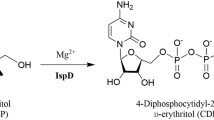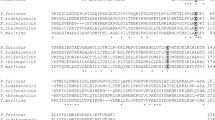Abstract
Extraction and purification from the biomass of Corynebacterium ammoniagenes of 2-C-methyl-D-erythritol 2,4-cyclopyrophosphate (MEC) was associated with its spontaneous transformation into a number of derivatives (which was due to the pyrophosphate bond lability and the formation of complexes with metals). These derivatives included 1,2-cyclophospho-4-phosphate, 2,4-diphosphate, 2,3-cyclophosphate, 1,4-diphosphate, and 3,5-diphosphate (identified by 1H, 31P, and 13C NMR spectroscopy) and accounted for about 10% of the MEC. When added to a solution of DNA in the presence of the Fenton reagent, MEC prevented DNA decomposition. In addition, MEC slowed down the interaction of the reagent with tempol radicals, which indicates that complexation of ferrous ions by MEC attenuates their ability to catalyze the formation of hydroxyl radicals from hydrogen peroxide. In the presence of 0.23 mM MEC, the rate of respiration of rat liver mitochondria increased by 1.8 times. At 0.1–1.0 mM, MEC activated in vitro proliferation of human Vgamma9 T cells. It is suggested that MEC acts as an endogenous stabilizing agent for bacterial cells subjected to oxidative stress and as an immunomodulator for eukaryotic hosts.
Similar content being viewed by others
REFERENCES
Ostrovskii, D.N., Uspekhi biol. khimii, 1997, vol. 37, pp. 147–169.
Potapov, V.D., Biketov, S.F., Demina, G.R., et al., Prikl. Biokhim. Mikrobiol., 2001, vol. 37, no.3, pp. 272–278.
Eberl, M., Altincicek, B., Kollas, A.K., et al., Immunology, 2002, vol. 106, no.2, pp. 200–212.
Feurle, J., Espinosa, E., Eckstein, S., et al., J. Biol. Chem., 2002, vol. 277, no.1, pp. 148–154.
Sicard, H., Al Saati, T., Delsol, G., and Fournie, J.-J., Mol. Med. (Tokyo), 2001, vol. 7, no.10, pp. 711–722.
Kollas, A.-K., Duin, E.C., Eberl, M., et al., FEBS Lett., 2002, vol. 532, no.3, pp. 432–436.
Hintz, M., Reichenberg, A., Altincicek, B., et al., FEBS Lett., 2001, vol. 509, no.2, pp. 317–322.
Jomaa, H., Wiesner, J., Sanderbrand, S., et al., Science, 1999, vol. 285, no.5433, pp. 1573–1575.
Kuzuyama, T., Biosci. Biotechnol. Biochem., 2002, vol. 66, no.8, pp. 1619–1627.
Okada, K., Kawaide, H., Kuzuyama, T., et al., Planta, 2002, vol. 215, no.2, pp. 339–344.
Giner, J.L. and Ferris, W., Organic Lett., 2002, vol. 4, no.7, pp. 1225–1226.
Lichtenthaler, H., Zeidler, J., and Muller, C., Z. Natur. ser. C, 2000, vol. 155, no.5/6, pp. 305–313.
Takagi, M., Kuzuyma, T., Kanada, K., et al., Tetrahedron Lett., 2000, vol. 41, no.18, pp. 3395–3398.
Hoeffler, J.F., Tritsch, D., Grosdemange-Billiard, C., and Rohmer, M., Eur. J. Biochem., 2002, vol. 269, no.18, pp. 4446–4457.
Herz, S., Wungsintaweekul, J., Schuhr, C., et al., Proc. Natl. Acad. Sci. USA, 2000, vol. 97, no.6, pp. 2486–2490.
Shchipanova, A.N., Kharat'yan, E.F., Sibel'dina, L.A., et al., Biokhimiya (Moscow), 1992, vol. 57, no.6, pp. 862–872.
Demina, G.R., Pleshakova, O.V., Sibel'dina, L.A., et al., Biokhimiya (Moscow), 1995, vol. 60, no.4, pp. 481–487.
Johnson, D. and Lardy H., Meth. Enzymol., 1967, vol. 10, pp. 94–96.
Shol'ts, K.F. and Ostrovskii, D.N., Labor. delo, 1965, no. 6, pp. 375–378.
Ostrovsky, D., Diomina, G., Shipanova, I., et al., Bio-Factors, 1993, vol. 4, no.3, pp. 154–159.
Duan, L., Gan, H., Golan, D., and Remold, H., J. Immunol., 2002, vol. 169, no.9, pp. 5181–5187.
Schoel, B. and Kaufmann, S., Microb. Pathol., 1998, vol. 24, no.3, pp. 197–201.
Pinegin, B.V., Otechestvennyi immunomodulyator “Polioksidonii”: mekhanizm deistviya i klinicheskoe primenenie (Native Immunomodulator Polyoxydoni: Mechanism of Action and Clinical Application), Moscow, 2000, pp. 6–8.
Author information
Authors and Affiliations
Rights and permissions
About this article
Cite this article
Ostrovsky, D.N., Dyomina, G.R., Deryabina, Y.I. et al. Properties of 2-C-Methyl-D-Erythritol 2,4-Cyclopyrophosphate, an Intermediate in Nonmevalonate Isoprenoid Biosynthesis. Applied Biochemistry and Microbiology 39, 497–502 (2003). https://doi.org/10.1023/A:1025452804046
Issue Date:
DOI: https://doi.org/10.1023/A:1025452804046




